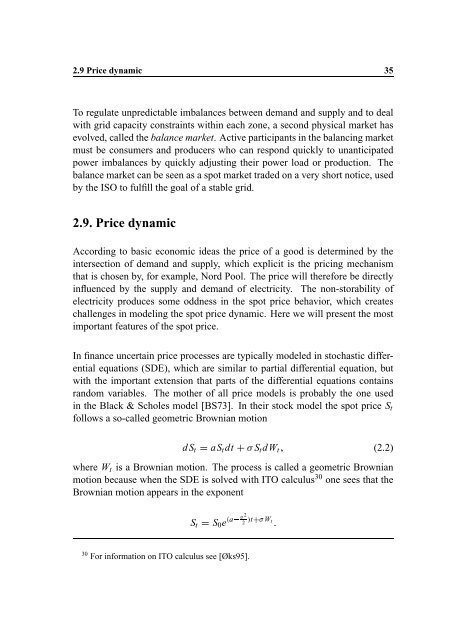Hedging Strategy and Electricity Contract Engineering - IFOR
Hedging Strategy and Electricity Contract Engineering - IFOR
Hedging Strategy and Electricity Contract Engineering - IFOR
Create successful ePaper yourself
Turn your PDF publications into a flip-book with our unique Google optimized e-Paper software.
S 0 eH aIKJ<br />
2.9 Price dynamic 35<br />
To regulate unpredictable imbalances between dem<strong>and</strong> <strong>and</strong> supply <strong>and</strong> to deal<br />
with grid capacity constraints within each zone, a second physical market has<br />
evolved, called the balance market. Active participants in the balancing market<br />
must be consumers <strong>and</strong> producers who can respond quickly to unanticipated<br />
power imbalances by quickly adjusting their power load or production. The<br />
balance market can be seen as a spot market traded on a very short notice, used<br />
by the ISO to fulfill the goal of a stable grid.<br />
2.9. Price dynamic<br />
According to basic economic ideas the price of a good is determined by the<br />
intersection of dem<strong>and</strong> <strong>and</strong> supply, which explicit is the pricing mechanism<br />
that is chosen by, for example, Nord Pool. The price will therefore be directly<br />
influenced by the supply <strong>and</strong> dem<strong>and</strong> of electricity. The non-storability of<br />
electricity produces some oddness in the spot price behavior, which creates<br />
challenges in modeling the spot price dynamic. Here we will present the most<br />
important features of the spot price.<br />
In finance uncertain price processes are typically modeled in stochastic differential<br />
equations (SDE), which are similar to partial differential equation, but<br />
with the important extension that parts of the differential equations contains<br />
r<strong>and</strong>om variables. The mother of all price models is probably the one used<br />
in the Black & Scholes model [BS73]. In their stock model the spot price S t<br />
follows a so-called geometric Brownian motion<br />
dS t aS t dt F S t dW t G (2.2)<br />
where W t is a Brownian motion. The process is called a geometric Brownian<br />
motion because when the SDE is solved with ITO calculus 30 one sees that the<br />
Brownian motion appears in the exponent<br />
S t<br />
2<br />
2 L tMON W t P<br />
30 For information on ITO calculus see [Øks95].
















